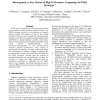Free Online Productivity Tools
i2Speak
i2Symbol
i2OCR
iTex2Img
iWeb2Print
iWeb2Shot
i2Type
iPdf2Split
iPdf2Merge
i2Bopomofo
i2Arabic
i2Style
i2Image
i2PDF
iLatex2Rtf
Sci2ools
126
Voted
HCW
2000
IEEE
2000
IEEE
Heterogeneity as Key Feature of High Performance Computing: the PQE1 Prototype
In this work we present the results of a project aimed at assembling an hybrid massively parallel machine, the PQE1 prototype, devoted to the simulation of complex physical models. The analysis of some of the existing parallel architectures has revealed that general-purpose machines are largely over-dimensioned and often perform inefficiently in grand-challenge scientific applications. We have thus developed an heterogeneous parallel system which matches task-heterogeneity with architecture-heterogeneity: in fact special-purpose massively parallel architectures, when coupled to general-purpose machines, are able to efficiently satisfy the requirements of complex scientific computing. We present the HW structure and the SW tools developed for the PQE1 prototype. Starting from the concept of machine-granularity and task-granularity, we show the necessity to exploit both high granularity and low granularity parallelism to efficiently use the PQE1 system. Some examples describing applicat...
Distributed And Parallel Computing | HCW 2000 | Massively Parallel | Parallel Architectures | PQE1 Prototype |
Related Content
| Added | 31 Jul 2010 |
| Updated | 31 Jul 2010 |
| Type | Conference |
| Year | 2000 |
| Where | HCW |
| Authors | Paolo Palazzari, Lidia Arcipiani, Massimo Celino, Roberto Guadagni, Alessandro Marongiu, Agostino Mathis, Paolo Novelli, Vittorio Rosato |
Comments (0)

